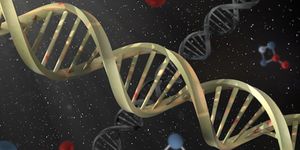It's Now Possible to Measure tRNA Levels in Cells
There are different kinds of ribonucleic acids that play essential roles in many aspects of molecular biology, including the creation of proteins from gene sequences in DNA. One type of ribonucleic acid (RNA) called transfer RNA (tRNA) ferries amino acids, the building blocks of proteins, to molecular machines known as ribosomes. Therefore, researchers have known that tRNA levels can affect the physiology of cells. But it's difficult to measure the amount of tRNA in cells. Researchers may have now found a way to do so, which they call mim-tRNAseq.
Every three base pairs of DNA encodes for one amino acid, but there is redundancy in the code so there are 61 three-base-pair sequences or codons that encode for 20 amino acids. Each tRNA molecule is made up of a short sequence of nucleotides, about 70 to 90 bases in length. Many of these nucleotides are chemically modified so the tRNA molecule will fold into a cloverleaf shape. One of the 20 amino acids sits at the end of each tRNA molecule.
Each cell is estimated to contain several hundred thousand tRNA molecules, but the amount of each tRNA molecule varies by tissue and throughout development. They may also change when disease occurs; the mim-tRNAseq method will hopefully tell us more about that.
The researchers utilized an enzyme called reverse transcriptase, which can turn RNA molecules into DNA molecules. After generating millions of copies of DNA from multiple RNAs, high-throughput sequencing was used to quantify the levels of that DNA (which represented the initial tRNA molecules). This method has not been utilized before since it's been difficult to use tRNA as a template for reverse transcriptase to make DNA from, because the many chemical modifications on tRNA interfere with that process, stopping the synthesis of DNA.
"Many researchers have proposed elegant solutions to this problem, but all of them relieve only a fraction of the modification roadblocks in tRNAs," explained Danny Nedialkova, Max Planck Research Group Leader at the Max Planck Institute of Biochemistry. "We noticed that one specific reverse transcriptase seemed to be much better at reading through modified tRNA sites. By optimizing the reaction conditions, we could significantly improve the enzyme's efficiency, enabling it to read through nearly all tRNA modification roadblocks."
With this technique, the researchers claim that DNA libraries can now be made from full-length tRNA molecules with enough efficiency and accuracy that they will enable the quantification of the initial template. They used computational tools to ensure the tRNA sequences will be read correctly even though many of their sequences are highly similar.
The freely available mim-tRNAseq tool can now be used by other researchers to measure tRNA abundance and explore other research questions.
"mim-tRNAseq opens up myriad possibilities moving forward," said Nedialkova. "We expect it will help us and others to tackle many outstanding questions about tRNA biology in health and disease."
Sources: AAAS/Eurekalert! via Max-Planck-Gesellschaft, Molecular Cell









